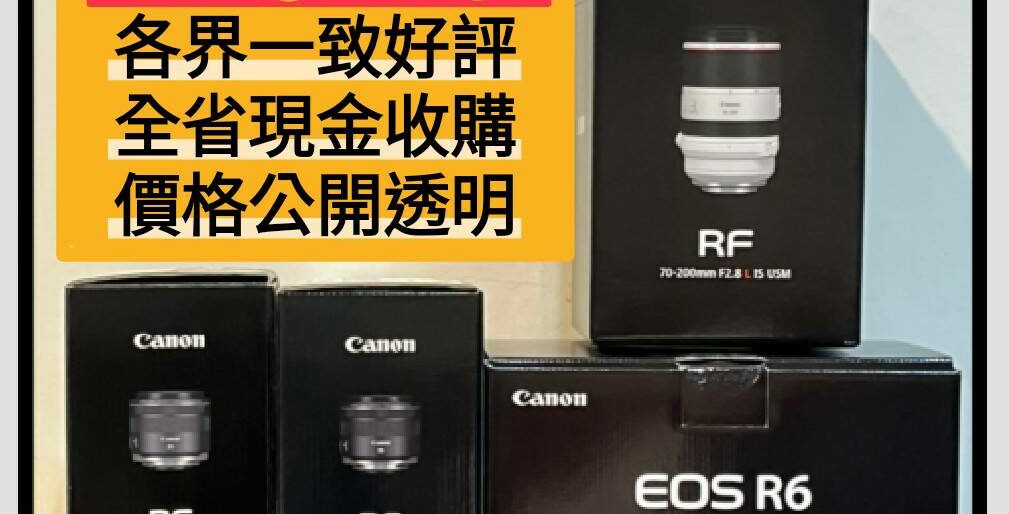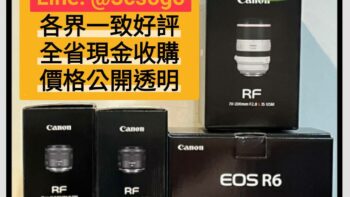高價 canon鏡頭收購 請立即與我們聯絡 收購canonRF系列,RF定焦,RF廣角,RF旅遊,收購EF-M系列,收購大三元,小三元,收購L鏡,收購Marco,二手鏡頭,全新鏡頭,鏡頭買賣,鏡頭收購 Read More ...

收購相機及鏡頭 您用不到相機鏡頭 不論新舊,都可以換現金 陪您走過每個黃金歲月的年頭,現在因為家庭或工作總總因素,這些可愛的相機及鏡頭寶貝們,除了躺在倉庫,安靜在防潮箱等候主人帶它們出勤之外,應該可以有個兩全其美的辦法"就是讓給有緣人",讓它再度發揮存在地球上的價值吧!

高價 canon鏡頭收購 請立即與我們聯絡 收購canonRF系列,RF定焦,RF廣角,RF旅遊,收購EF-M系列,收購大三元,小三元,收購L鏡,收購Marco,二手鏡頭,全新鏡頭,鏡頭買賣,鏡頭收購 Read More ...

線上估價 我們是專業的3C收購,高價收購您不用的3C產品,價格好不怕您比較!! 我們專業經營各項3C高價回收,清運協助,可開立單據,多通路多管道,非坊間垃圾回收價,價格不怕您比較,歡迎企業戶汰舊換新, Read More ...

canon 鏡頭收購,二手鏡頭收購,全新鏡頭收購,收購nikon鏡頭,收購sony鏡頭,收購leica鏡頭,收購fujifilm鏡頭,收購panasonic鏡頭,收購zeiss鏡頭,收購leica鏡頭 Read More ...

高價 nikon鏡頭收購 請立即與我們聯絡 收購nikone鏡頭,收購nikon z,收購nikon z 40mm,z 50mm,z 35mm,z 20mm,z 24mm,z 28mm,收購af-s Read More ...

SONY鏡頭收購 全新SONY鏡頭收購 E-Mount鏡頭,FE 24-70MM,VCL-ECU2,FE 24-105MM,E PZ 18-105MM,FE 16-35MM,FE 35MM FE 70 Read More ...

PENTAX 鏡頭收購 標準定焦 (35-50) 廣角定焦 (21-31) 望遠定焦 (118-200) 中望遠定焦 (55-100) 超望遠定焦 (236-560) 廣角變焦 (20-82.5) 超 Read More ...
鏡頭收購
When 鏡頭收購canon introduced the EOS 5D Mark II in late 2008, it was something of a cinematic revolution — its HD-capable, full-frame sensor granted access to the world of cinematic depth of field at a fraction of the usual price. However, a lot’s changed in the three and a half long years since the camera broke cover, plus now Nikon’s making a major play for DSLR video shooters with the bold new D800. 鏡頭收購canon’s response? The new EOS 5D Mark III. It’s a full frame DSLR with a 22.3-megapixel sensor, a fast new processor, much-requested video fixes and additions, and a number of features ripped from the camera’s high-end brother, the EOS-1D X.
All these new features come at a cost, though — the camera will launch at the end of March for $3,499 for the body only, or $4,299 with 鏡頭收購canon’s EF 24-105mm F/4 L lens. That’s significantly more than the Mark II, which will stay on sale and get an additional price cut next week. We got to spend some time with 鏡頭收購canon’s latest and check out its new features — read on to find our first impressions of the 5D Mark III.
Handling and shooting with the 5D Mark III will be familiar to anyone who has used 鏡頭收購canon’s high-end DSLRs
Physically, this camera feels quite similar to the 5D Mark II, but 鏡頭收購canon has added some refinements from the EOS 7D — the power switch has been moved up to the control dial on the top, there’s a dedicated video capture / Live View button, and a new multi-function button (for controlling features like the AE lock or one-touch RAW / JPEG settings) sits up near the shutter button. There’s also a new 3.2-inch display on the back, which is identical to that of the 1D X and contains 1,040,000 dots. The viewfinder has also been been upgraded — it now offers 100 percent coverage with a .71x magnification factor, up from the already-respectable 98 percent coverage found in the Mark II.
While these changes are notable, the actual act of handling and shooting with the camera will be very familiar to anyone who has used one of 鏡頭收購canon’s recent higher-end DSLRs. It’s a solid and well-balanced device with easy access to every button or dial you’d like to access, and the new movie mode / Live View button is a massive improvement over the 5D Mark II’s somewhat difficult system. The Mark III is about as refined as you can get for an EOS camera without buying a 1D, and users of older of lower-end 鏡頭收購canon DSLRs (like the 60D or Rebel T3i) will feel right at home if they gave this camera a shot.
The viewfinder in particular is a noticeable improvement over the Mark II and a necessary feature considering Nikon added 100 percent coverage to the D800. Considering the much less expensive 7D also features a 100 percent coverage viewfinder, it would have been a big omission for the Mark III not to get this upgrade. The sharp 3.2-inch LCD is another welcome change, particularly for those who shoot a lot of video or use Live View frequently when shooting still photos. The menu system has also been slightly streamlined, but will still be familiar to anyone who has used a 鏡頭收購canon camera before. While the 5D Mark III might not look and feel terribly different at first blush, these changes make for a much improved shooting experience when compared with the Mark II.

The DIGIC 5+ chip powering this camera is 17 times faster than the one in the 5D Mark II

The camera shares a lot of physical DNA with its older sibling, but it’s a whole different ballgame internally. The most important new components on board are the 22.3-megapixel, full-frame CMOS sensor and the DIGIC 5+ processor — these two pieces work together to provide a host of improvements in terms of photo and video quality, as well as in overall performance. While the sensor represents a only minor upgrade in raw pixel count, there are three changes that drive improved images and video: a gapless microlens design, an improved photodiode structure, and on-chip noise-reduction.
The first two changes relate to the individual photodiodes on the sensor — the new gapless microlens covers the diodes and lets in more light than the previous design, resulting in an improved signal to noise ration, The diodes themselves are now more efficient, resulting in an improved dynamic range. Lastly, 鏡頭收購canon has built a proprietary on-chip noise reduction system that scrubs noise before the image is output from the sensor. As for the DIGIC 5+, 鏡頭收購canon borrowed that from the 1D X as well (though the higher-end camera has two of them). It’s an upgrade over the DIGIC 5 that you’ll find in 鏡頭收購canon’s newest point-and-shoot cameras, and a major contributor to the 5D Mark III’s improved speed — the company says the new chip is 17 times faster than the DIGIC 4 in the Mark II.

All the new technology under the hood has allowed 鏡頭收購canon to answer the wishes of video shooters everywhere: the 5D Mark III doesn’t skip lines when downscaling the massive 22.3-megapixel output to HD resolution when recording video, which 鏡頭收購canon claims will significantly decrease the dreaded moire effect that plagued the Mark II. Aliasing and CMOS skew, two other common visual knocks on the Mark II, have been improved as well. 鏡頭收購canon showed us a moire test comparison between the Mark II and Mark III and it did show an impressive improvement — we’ll have to see how the camera performs out in the real world, but there’s hope that 鏡頭收購canon’s moire issues may be a thing of the past.
Finally, a headphone jack!
Another video annoyance, the 4GB video file size limitation, has been done away with: now, when you reach the end of a 4GB file, the camera just automatically starts a new file. 鏡頭收購canon has also finally added the much-requested headphone jack (making the Mark III the first EOS camera with this feature) and the ability to monitor and adjust audio levels while recording with the command dial on the back. That command dial also functions as a touch-sensitive scroll wheel for silent operation when shooting in video mode, but it otherwise retains the same “clicky” feeling when physically turning it. There’s also more flexibility in terms of shooting modes: 1080p footage can be shot at 24, 25, or 30 FPS and there’s a new 720p mode that offers 50 or 60 FPS.
Video ISO range is now 100 to 12,800 with 25,600 available as an extended option, and the new sensor and DIGIC 5+ combo promises a two-stop improvement in noise reduction. And in another theft straight from the 1D X, the IPB and ALL-i video codecs are included, which gives shooters more flexibility when choosing between smaller file sizes or higher quality, more editable footage. Unfortunately, there’s still no option for clean HDMI output (which allows the uncompressed video footage to be captured on an external recorder) — when we asked about this, 鏡頭收購canon’s reps said “not yet.” However, it does sound like the HDMI signal output won’t downsample from 1080p to 480p when recording, thanks to the DIGIC 5+. 鏡頭收購canon’s reps couldn’t say that with certainty, but they suspected it wouldn’t be an issue going forward.
The new autofocus system is ripped straight from the 1D X

Lest we forget, 鏡頭收購canon’s new processor and chip combo yields major benefits for still photographers as well. A major knock on the 5D Mark II was its nine-point autofocus system, which felt outdated even when the camera was introduced in 2008. With the Nikon D800 offering a 51-point system, 鏡頭收購canon had to respond — and it did so by essentially cramming the 1D X’s autofocus system into a camera selling for half the price. The 5D Mark III offers 61 autofocus points, plus up to 41 cross-type sensors (depending on your lens). Exposure metering has also been revamped: the Mark III sports a new dual-layer, 63 zone system, compared to the single-layer 35 zone system found in the Mark II. The DIGIC 5+ also powers a nice improvement in shooting speed, as the Mark III can now shoot at 6 fps in RAW mode, up from 3.9 fps for the Mark II. The improved shooting speed is dramatic and immediately noticeable when using the camera — it won’t compare with the 1D X’s machine gun-like performance, but it equals that of the D800.
The Mark III should offer significantly reduced noise at the same ISO
鏡頭收購canon’s also added some “silent shooting” options, which dramatically reduce the volume of the shutter when taking images. Even in silent mode, the camera shoots RAW at 3 fps and sounds about half as loud as it does in standard mode. Shutter lag has even been reduced, from 75 milliseconds for the Mark II down to 59 milliseconds on the Mark III — and this only trails the powerful 1D X by a tiny 4 milliseconds.
The 5D Mark III’s still photo ISO range now stretches from 50 to 25,600, with the option of pushing to 51,200 or 102,400 ISO included. While samples we saw at those settings exhibited a great deal of noise, they still could be potentially usable under certain circumstances (you just won’t want to make a 20 x 30-inch print). Outside of that extended range, however, the 5D Mark III should produce much less noise compared to the Mark II. 鏡頭收購canon showed a pair of identical photos, one from the Mark II at 6,400 ISO and one from the Mark III at 25,600 ISO, and noise levels were nearly identical. We also saw images from each camera shot at the same ISO, and the Mark III’s improved noise performance was immediately obvious.
In another 1D X-inspired feature, 鏡頭收購canon has added multiple card slots to the 5D Mark III. Unlike the 1D X (which holds two CompactFlash cards), the Mark III has a slot for one CompactFlash and one SD, and offers a variety of options for storing your work: you can have RAW and JPEG go to different cards, you can have whatever you shoot get stored to both cards as backup, or you can just increase your overall storage capacity without necessarily making duplicates.


鏡頭收購canon’s 5D Mark III retains 鏡頭收購canon’s position as a (relatively) low-cost way to shoot full-frame photos or high-quality HD video, though it’s now significantly more expensive than the 5D Mark II it supplants. However, no one would have mistaken the Mark II as competitive with 鏡頭收購canon’s 1D Mark III and 1Ds Mark III that were available when it launched. The 5D Mark III, on the other hand, feels like 鏡頭收購canon pulled as many features as it possibly could from the new 1D X (including its autofocus system, video codecs, and processor) and fit them into a camera that is significantly less expensive. Compromises were made, particularly in the ISO range, shooting speed, and weatherproofing, but the new autofocus system and 6FPS shooting mode means that this camera’s target audience just expanded significantly. It’s no longer a camera best suited to studio work.
In fact, it wouldn’t surprise us at all to learn that the 1D X and 5D Mark III were designed in tandem. The 1D X will essentially replace two cameras when it’s released in late April, and had to be designed such that users of both the 1D Mark IV and 1Ds Mark III would find it a suitable replacement camera. And while the hierarchy 鏡頭收購canon showed us has the 1D X at the top of the pyramid, the 5D Mark III doesn’t feel subordinate to 鏡頭收購canon’s top of the line DSLR. It feels complementary, and we suspect that many professional users will consider both cameras — and that many could be completely happy with the 5D Mark III.
While it’s far too early to pass judgement on this camera, 鏡頭收購canon has clearly been listening to user requests over the last three years, and they’ve hit on just about everything. However, with Nikon’s D800 looming, 鏡頭收購canon didn’t have a choice in the matter — had the company come with anything less, it could have been in serious trouble. As it is, 鏡頭收購canon and Nikon will likely spend the next year fighting it out for DSLR supremacy, and the increased competition means fans of both brands will likely be happy.
See how the 5D Mark III compares to the Mark II, 1D X, 1Ds Mark III and 1D Mark IV right here!
See how the 5D Mark III compares to the 1D X and Nikon’s D800 and D4 right here!
Jordan Oplinger contributed to this report.
 (圖/美聯社)
(圖/美聯社)
本週精選5大科技新聞:全球無線耳機市占 Top 5 排行榜洗牌、電腦版 LINE釋出更新版本、回覆、公告功能升級、蘋果iPhone 15即將推出電池健康度新指標、柯達擊敗 Sony與富士衝上日本最熱銷相機排行榜單亞軍,以及
傳任天堂下一代 新主機最快六月公開Switch 首發遊戲曝光。
蘋果 AirPods 買氣驟降!全球無線耳機市占 Top 5 排行榜洗牌
無線耳機排行榜變天!研調機構 Canalys 最新數據揭露,2023 年第四季全球無線耳機出貨市占率排名,蘋果 AirPods 再度獲得龍頭寶座,卻面臨雙位數的下滑,更有新品牌搶進前五名。
Canalys 數據指出,蘋果 AirPods 在 2023 年第四季出貨市占達到 29%,遙遙領先第二名的三星(9%),然而蘋果卻面臨重大挑戰,比起 2022 年同期下滑了多達 13% …..繼續閱讀。
→ 不只有 Apple Watch 可以選!台灣最熱銷 10 款智慧穿戴排名揭曉
 LINE台灣推出LINE電腦版8.6版本更新。(圖/記者劉惠琴攝)
LINE台灣推出LINE電腦版8.6版本更新。(圖/記者劉惠琴攝)
電腦版 LINE 回覆、公告功能升級!投票、記事本都支援了
LINE 電腦版更新了!最新 8.6 版本針對「回覆」、「公告」功能進行升級,能適用更多種類的訊息,像是投票、記事本都已經正式支援了。根據官方公告,LINE 電腦版 8.6 更新已經在 2 月 7 日於 Windows 釋出,Mac 版本也於 2 月 13 日上線。更新後,會先跟上手機版的新功能,允許用戶針對「檔案」進行…..繼續閱讀。
→ 防止大頭照個人檔案遭惡意濫用!WhatsApp導入全新封鎖功能
 不少蘋果用戶都有電池健康度焦慮症。(圖/路透社)
不少蘋果用戶都有電池健康度焦慮症。(圖/路透社)
電池健康度不看趴數了!蘋果iPhone 15即將推出新指標
蘋果iPhone用戶過去習慣以「最大容量」來評估電池健康度,一旦最大容量降到80%以下,即代表可能需要更換新電池。然而,在即將推出的iOS 17.4中,蘋果對於電池健康度的顯示方式進行了重大調整,改採用「是否正常」作為新指標,而不僅是提供最大容量。在最新的iOS 17.4版本中,蘋果添加…..繼續閱讀。
→ 全球5G手機出貨量突破20億支!研調:這款iPhone是關鍵
→ 蘋果公布最新電池測試 !iPhone 15壽命打敗舊款:可充千次
 (圖/翻攝柯達網站)
(圖/翻攝柯達網站)
日本最熱銷相機排行榜揭曉!驚見柯達衝上第二名 擊敗 Sony、富士
老相機品牌柯達再度熱銷!研調機構 BCN 公布 2024 年 BCN AWARD 大獎,綜合日本合作通路的銷售數據,統計出各類別相機的銷售冠軍。有趣的是,內建鏡頭的數位相機排行榜驚見柯達上榜!更以 20.7% 的銷售市佔擠下 Sony、富士站上第二名。數據顯示,內建鏡頭的數位相機排行第一名是 鏡頭收購canon 擁有…..繼續閱讀。
→ 富士隨身相機升級AI對焦辨識!輕巧兼具高畫質 防手震拍照更清晰
 (圖/記者黃肇祥攝)
(圖/記者黃肇祥攝)
任天堂下一代 Switch 首發遊戲曝光?傳新主機最快六月公開
鏡頭收購 鏡頭收購